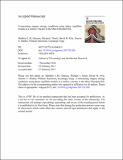Constraining magma storage conditions at a restless volcano in the Main Ethiopian Rift using phase equilibria models
Abstract
The Main Ethiopian Rift hosts a number of peralkaline volcanic centres, with many showing signs of recent unrest. Due, in part, to the low number of historical eruptions recorded in the region, volcanism in the Main Ethiopian Rift remains understudied relative to other volcanic settings and conditions of magma storage remain almost entirely unknown. Aluto is one of these restless caldera systems and identifying magma storage conditions is vital for evaluating the risks posed by recent periods of unrest. In this study, we ran ~ 150 fractional crystallisation models, using the Rhyolite-MELTS thermodynamic software, within the range P = 50–300 MPa, starting H2O = 0.5–3 wt% and fO2 = QFM-2 − QFM + 1. This represents a realistic range of potential magma storage conditions at Aluto. We assessed the fractionation trends produced using two different starting compositions, which represent different estimates of the parental melt feeding the system. The predicted liquid lines of descent produced by these models are compared with Aluto whole-rock data from the literature, and are presented along with new observations of the natural phase assemblage and erupted mineral compositions to provide information on the magma storage conditions. Using a new, quantitative statistical approach to compare empirical data and thermodynamic model-outputs, we find that the compositions of evolved peralkaline rhyolites from Aluto are best reproduced by isobaric fractional crystallisation from a rift-related basaltic composition, without the need for significant crustal assimilation. Around 90% protracted fractional crystallisation is required to produce these compositions. This indicates that the magmatic system is likely to exist as a highly crystalline mush. The best agreement between models and natural samples is at low pressures (150 MPa), low initial H2O concentrations (0.5 wt%) and relatively high oxygen fugacity (QFM). The depth of magma storage derived from these results (~ 5.6 ± 1 km) agrees well with the source depths modelled from measured ground deformation at Aluto in 2008. Data from other peralkaline volcanic centres in the Main Ethiopian Rift, such as Boset and Gedemsa, and at other locations globally (e.g. Pantelleria, Italy) suggest that these storage conditions are a common feature of many peralkaline volcanic centres. Our data is consistent with the formation of a Daly Gap at Aluto due to compositional stratification of the magma reservoir beneath the caldera, and the non-linear relationship between temperature and SiO2 concentration during magmatic differentiation.
Citation
Gleeson , M L M , Stock , M J , Pyle , D M , Mather , T A , Hutchison , W & Yirgu , G 2017 , ' Constraining magma storage conditions at a restless volcano in the Main Ethiopian Rift using phase equilibria models ' , Journal of Volcanology and Geothermal Research , vol. 337 , pp. 44-61 . https://doi.org/10.1016/j.jvolgeores.2017.02.026
Publication
Journal of Volcanology and Geothermal Research
Status
Peer reviewed
ISSN
0377-0273Type
Journal article
Description
This work is a contribution to the Natural Environment Research Council (NERC) funded RiftVolc project (NE/L013932/1, Rift volcanism: past, present, and future). W.H., T.A.M., and D.M.P. are supported by and contribute to the NERC Centre for the Observation and Modelling of Earthquakes, Volcanoes, and Tectonics (COMET). W.H. M.J.S. were supported by a NERC studentships NE/J5000045/1 and NE/K500811/01 respectively.Collections
Items in the St Andrews Research Repository are protected by copyright, with all rights reserved, unless otherwise indicated.

